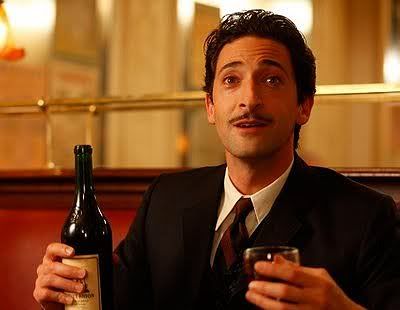
Pictured: Adrien Brody steals his scene as Salvador Dali
Paris in the 1920s. The subject of universal fantasy, whether you’re the intellectual who feels he has been born in the wrong era or the student ogling at the idea that these mythic figures of art and literature were in fact real people, let alone close chums. This fantasy is captured to dazzling perfection in Woody Allen’s latest Euro-city-centric film, Midnight in Paris.
Screenwriter Gil (Owen Wilson) is suffering a crisis of conscience on two levels: one being that he longs to revisit his dream of being a novelist, but fears his novel isn’t any good, the other being that he’s beginning to discover he might not truly be head over heals for his shrill fiancée, Inez (Rachel McAdams). The couple are visiting her parents in Paris, where Gil once dreamed of living the ex-pat lifestyle in the vein of his idols (Hemingway, Fitzgerald, Stein, the whole gang). In an effort to get the creative juices flowing, so to speak, Gil becomes fond of late night strolls through the inexplicably enchanting city. The trick? Each night at the stroke of 12, a buggy arrives promptly, filled with partying flappers (or TS Eliot and Hemingway) to transport him back into the 1920s, where he fits right in rubbing shoulders with the literary and artistic giants of the era.
Perhaps the best decision Mr. Allen makes regarding his whimsical storyline is that he at no points attempts to explain it. Naturally Gil is in disbelief at first, and wonders offhandedly if he is suffering some kind of neurological disorder, or as Inez puts it when he attempts to confide in her his secret for a second time, “Your brain tumor is acting up.” However, it doesn’t take much time for him to just go with it. It takes the audience even less.
What Mr. Allen seems to understand the most, and is in my opinion the primary reason the film is as successful as it is (both structurally and at the box office) is that people quite simply enjoy picturing Paris as this kind of fairytale world of culture and ideas, as well as their perception of those who gave it this reputation.
For example, the Fitzgeralds play a major role as Gil’s initial guides into the nightlife of 1920s Paris. Now, we know plenty about the complicated relationship between Scott, Zelda, and Hemingway, and where the film could have taken the opportunity to delve below this surface, it rather affirms it, giving a light-hearted touch to our clichéd knowledge that Zelda was crazy and Hemingway hated her. Case and point, Gil and his companion Adriana (an exquisite-as-always Marion Cotillard) happen upon Zelda (Allison Pill) preparing to leap into the Seine and end her own life. To diffuse the situation, Gil offers a valium. Also worth note, the scene in which Gil attempts to explain time travel to a table of surrealists including Dali and Bunuel...naturally they think it makes perfect sense.
Mr. Allen’s choice to promote the caricatures of these figures rather than portray them as the destitute, suicidal alcoholics so many of them were (somehow Hemingway is one of the funniest characters in the film?) is the key to helping Gil (and the audience, for that matter) not only fulfill his fantasy, but realize that life can go on without it. Ultimately, life’s worth is not measured by time or nostalgia, but by places and above all, people.